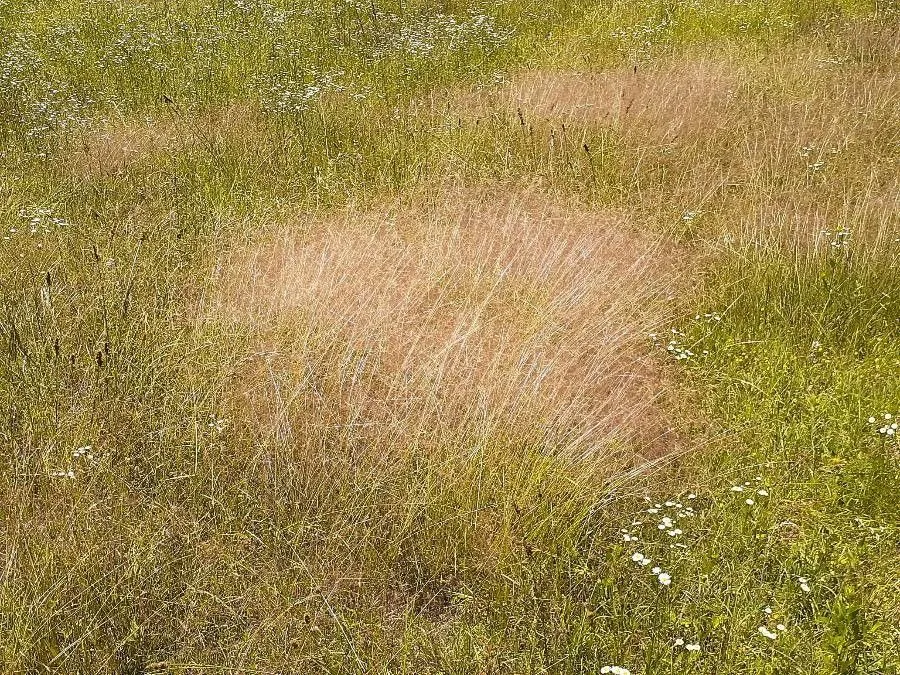
Author: (Pursh) Steud.
Bibliography: Nomencl. Bot., ed. 2, 1: 564 (1840)
Year: 1840
Status: accepted
Rank: species
Genus: Eragrostis
Vegetable: False
Observations: S. Canada to NE. Mexico
Purple love grass, scientifically known as Eragrostis spectabilis, is a perennial grass species that belongs to the Poaceae family. This striking ornamental grass is native to a broad range extending from Southern Canada to Northeastern Mexico. It was first described in detail in 1840 by botanist (Pursh) Steud., and its name was officially cited in the second edition of “Nomencl. Bot.”.
Purple love grass thrives in a variety of habitats, including prairies, open woodlands, and roadsides, favoring well-drained soils and sunny locations. Adaptable and resilient, it adds both ecological value and aesthetic appeal to its environments. Its delicate, airy inflorescences bloom in late summer to early fall, forming a striking carpet of purple that can turn fields and gardens into a vibrant tapestry. The tiny, purple-tinged spikelets are not only visually captivating but also attract various pollinators, contributing to the local biodiversity.
The foliage of Eragrostis spectabilis is equally attractive. Its green leaves form a tufted base and are fine-textured, offering a soft contrast to the more rigid structures often found in garden settings. As the seasons advance, the leaves may take on a bronze hue, adding seasonal interest to the landscape.
Ecologically, Purple love grass plays an essential role in preventing soil erosion due to its dense root system. It creates a stable ground cover, making it beneficial for restoration projects and sustainable landscaping. Furthermore, it provides habitat and food for numerous insects and animals, fostering a healthy ecosystem.
In cultivation, Purple love grass is admired for its low maintenance and drought tolerance. It is often utilized in garden borders, rock gardens, and as a ground cover. This ornamental grass pairs well with other native species, particularly those with contrasting textures and colors, to create dynamic, naturalistic plantings.
To grow Eragrostis spectabilis successfully, gardeners should plant it in full sun and well-drained soil. Once established, it requires minimal watering and care, making it a sustainable choice for eco-conscious landscapes. Its adaptability to different growing conditions, coupled with its unique beauty, ensures that Purple love grass remains a cherished addition to any garden or restoration project.
In summary, Eragrostis spectabilis, or Purple love grass, is a valuable and visually pleasing grass that offers numerous ecological and ornamental benefits. Its resilience and adaptability make it a superb choice for various landscaping uses across its native range from Southern Canada to Northeastern Mexico.
Eng: purple love grass, purple lovegrass, petticoat-climber, tumblegrass lovegrass
Swe: purpurkärleksgräs
Fra: éragrostide brillante
En: Purple love grass, Purple lovegrass, Petticoat-Climber, Tumblegrass lovegrass
Fr: Éragrostide brillante
Sv: Purpurkärleksgräs
Taken May 6, 2019 by Agnes Sofia Sirait (cc-by-sa)
Taken Sep 23, 2022 by Yelmo Yelmo Rad (cc-by-sa)
Taken Nov 10, 2022 by paola catale (cc-by-sa)
Taken Jun 2, 2020 by Aaron Harp (cc-by-sa)
Taken Aug 12, 2022 by William Coville (cc-by-sa)
© copyright of the Board of Trustees of the Royal Botanic Gardens, Kew.
Taken Jan 1, 1900 by EOL − Gerrit Davidse (cc-by-nc-sa)
Taken Jan 1, 1900 by EOL − Gerrit Davidse (cc-by-nc-sa)
Taken Aug 19, 2015 by EOL − Jenny Smith (cc-by-nc)
Taken Aug 31, 2015 by EOL − Jenny Smith (cc-by-nc)
Taken Jun 2, 2020 by Aaron Harp (cc-by-sa)
Taken Aug 27, 2019 by Riley L (cc-by-sa)
Taken Oct 15, 2019 by Vika Praprotnik (cc-by-sa)
Taken Oct 3, 2022 by jef weisel (cc-by-sa)
Taken Jan 1, 1900 by EOL − John Hilty (cc-by-nc)
Taken Jan 1, 1900 by EOL − Gerrit Davidse (cc-by-nc-sa)
Taken Aug 26, 2022 by johann m (cc-by-sa)
Taken Jul 20, 2022 by Ke Gai (cc-by-sa)
Taken Oct 18, 2018 by karlien heremans (cc-by-sa)
Taken Jun 2, 2020 by Aaron Harp (cc-by-sa)
Taken Oct 6, 2021 by Stefan (cc-by-sa)
Taken Jan 1, 1900 by EOL − Gerrit Davidse (cc-by-nc-sa)
Taken Nov 20, 2013 by EOL − Ben VanderWeide (cc-by-nc)
Growth form>: Rhizomatous
Growth habit>: Graminoid
Growth rate>: Moderate
Ph maximum: 7.5
Ph minimum: 4.0
Family: Myrtaceae Author: (F.Muell.) K.D.Hill & L.A.S.Johnson Bibliography: Telopea 6: 402 (1995) Year: 1995 Status:…
Family: Rubiaceae Author: Pierre ex A.Froehner Bibliography: Notizbl. Bot. Gart. Berlin-Dahlem 1: 237 (1897) Year:…
Family: Sapindaceae Author: Koidz. Bibliography: J. Coll. Sci. Imp. Univ. Tokyo 32(1): 38 (1911) Year:…
Family: Asteraceae Author: A.Gray Bibliography: Pacif. Railr. Rep.: 107 (1857) Year: 1857 Status: accepted Rank:…
Family: Fabaceae Author: Medik. Bibliography: Vorles. Churpfälz. Phys.-Ökon. Ges. 2: 398 (1787) Year: 1787 Status:…
Family: Aspleniaceae Author: (Cav.) Alston Bibliography: Bull. Misc. Inform. Kew 1932: 309 (1932) Year: 1932…